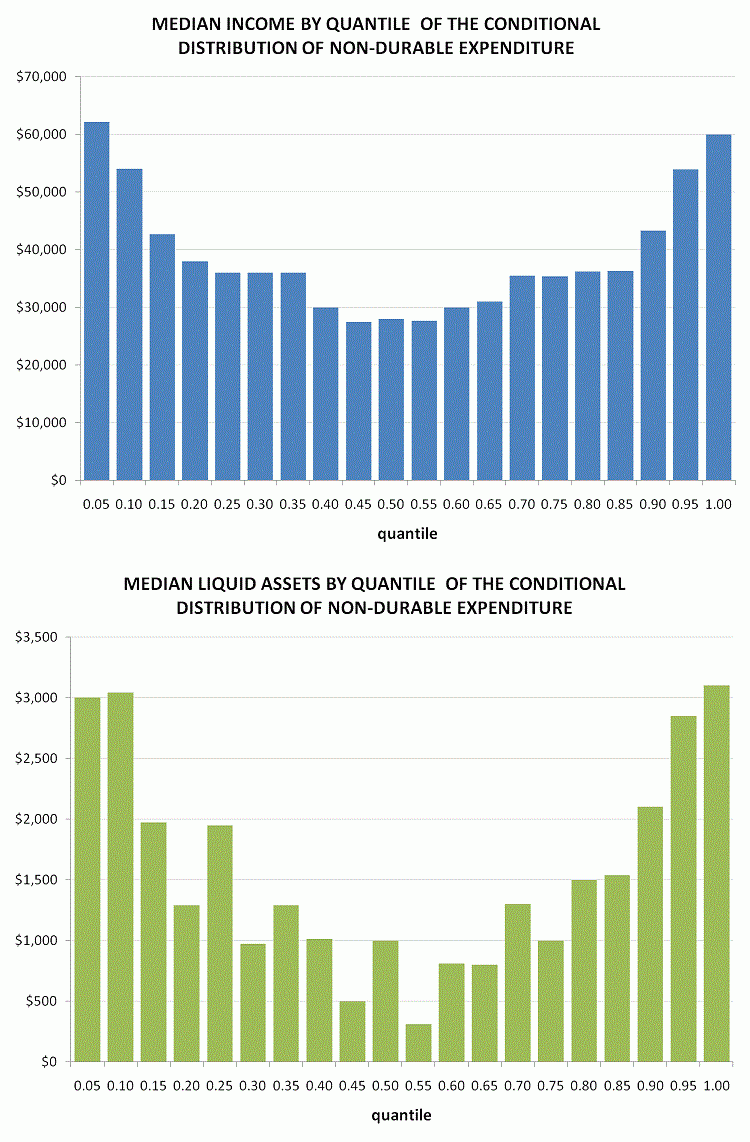In the aftermath of the recent financial crisis, governments around the world have sought to support the economy through unprecedented fiscal interventions. Considerable uncertainty (and disagreement among economists) exists, however, around the impact of these policies. At the heart of this uncertainty lies the recognition that the effects of fiscal stimuli, such as income tax rebates, on the aggregate economy cannot be fully understood without explicit consideration of distributional dynamics. This important insight feeds into a growing theoretical literature in macroeconomics which explicitly recognises that consumers and entrepreneurs are inherently different in their access to financial markets, life-cycle positions, patience, risk propensity, earning ability, and other individual characteristics.
On the empirical side, a large number of studies surveyed by Jappelli and Pistaferri (2010) have used exogenous variation in household income data to test for the permanent income hypothesis. Parker (1999), Souleles (1999), Shapiro and Slemrod (2003), and Johnson et al. (2006) evaluate the impact of the 2001 (or earlier) tax rebates in the US and find that families spent 20% to 40% of their rebates during the quarter of arrival, and spend about 67% of the rebate over two quarters.
Despite the emphasis on heterogeneity placed by the theory, there is little evidence on whether the response to income tax rebates varies across households and, more importantly from a macroeconomic perspective, whether a heterogeneous response model may yield predictions for the aggregate impact of the fiscal stimulus which are different from the predictions of the commonly employed homogeneous response model. Most of the available evidence, in fact, relies on restrictive parametric assumptions under which the estimates of a linear model can be interpreted as accurate measure of the average effect (across the entire population of tax filers) of the fiscal stimulus onto the real economy.
In a recent paper (Misra and Surico 2011), we estimate the heterogeneous responses to the 2001 income tax rebates across groups of American households endogenously determined within a sample of 13,066 families from the Consumption Expenditure Survey. We find that around 45% of the sample saved the entire value of the rebate. Another 20%, with low income and liquid wealth, spent a significant amount. The largest propensity to consume, however, was associated with the remaining 35% of households, with higher income or liquid wealth. As for the aggregate impact of the fiscal stimulus, the heterogeneous response model estimates that the income tax rebates added a 3.27% to aggregate non-durable consumption expenditure in the second half of 2001. The homogeneous response model, in contrast, predicts a 5.05% increase. This is a difference as large as $9 billion!
Beyond the representative agent model in empirical analysis
The Economic Growth and Tax Relief Reconciliation Act of 2001 approved to send income tax rebates, typically of $300 or $600 in value, to most US households in the second half of 2001. The main objective of these rebates was to increase household consumption and therefore stimulate the aggregate economy.
Several theoretical contributions have derived the conditions under which the aggregate implications of heterogeneous agent models may differ significantly from the predictions of representative agent models. Differences in the degree of access to credit markets, impatience, illiquid wealth and elasticity of intertemporal substitution may also be associated with differences in the expenditure response to a temporary tax cut.
To explore in the data the heterogeneity highlighted by the theory, we use quantile regression methods which are designed to estimate unobserved heterogeneity models. In particular, quantile regression methods yield a family of estimated marginal propensities to consume that vary across the conditional distribution of consumption changes. Furthermore, estimates are robust to non-normal distributions (e.g. fat tailed) of the error terms (Koenker 2005). This is an additional important advantage relative to least square methods, whose inference on the average effect is distorted by the presence of non-Gaussian disturbances.
The estimates of the heterogeneous model are reported in Figure 1. Here the vertical axis displays the within-quarter marginal propensity to consume (out of the tax rebate) and the horizontal axis shows the different quantiles of the consumption change distribution. The dotted blue line denotes the marginal propensity to consume (MPC) of 0.38 estimated using the homogenous response model (using two stage least square). The red line shows the estimates from the heterogeneous response model. The main finding is that there is indeed a large extent of heterogeneity in the responses to the tax rebates. In particular, around 45% of the sample saved the entire value of the rebate (MPC = 0), an additional 45% spent a significant amount (MPC > 0, MPC < 1) and the final 10% spent the entire value of the rebate (MPC = 1).
Figure 1. Evidence for heterogeneous response to 2001 tax rebates
The evidence in favour of heterogeneity rises an important issue about what factors may be driving the diverse responses to the tax rebate. Figure 2 reports evidence along these lines. The top (bottom) panel reports the median value of income (liquid wealth) for each quantile of the estimated conditional distribution of changes in non-durable consumption expenditure. Two findings are worth emphasising.
- First, both variables tend to have higher values at the tails. Note the behaviour at the left end is consistent with Ricardian equivalence (MPC= 0). On the other hand, households with the highest impact (MPC = 1) at the right tail enjoyed higher income and liquid wealth.
- Second, households with low income or low liquid wealth are concentrated in the 45 to 65 percentiles. According to the MPC estimates, these households spend a significant portion of the rebate, between 10% and 40%, and therefore their behaviour is consistent with the presence of liquidity constraints for 20% of the full sample. This number is not inconsistent with the fraction of liquidity constrained American families estimated by Jappelli et al. (1998) and Dogra and Gorbachev (2010) using independent data from the Survey of Consumer Finance.
Figure 2. Median income and median liquid assets by rank-score quantile of the conditional distribution of non-durable expenditure
Revisiting the aggregate effects of fiscal policy
What are the implications of heterogeneity in the MPC for the aggregate effects of fiscal policy? Does the heterogeneous response model provide a different answer relative to the conventional homogeneous response model? To answer these questions, we follow Johnson et al. (2006) and measure the aggregate impact of the tax rebates on the US economy in the second half of 2001 using the fact that the total amount of disbursement, $38 billion, represented 7.5% of the aggregate non-durable consumption in the third quarter of 2001.
The estimates of the heterogeneous model indicate that the income tax rebates boosted aggregate expenditure on non-durable goods and services by a significant 3.27%. This should be compared with the 5.05% implied by the homogeneous model estimates, which are based on the restriction that all households shared the same MPC. This difference implies that the homogenous response model overestimates the impact of the 2001 income tax rebates by $9 billion. Furthermore, the estimates of the homogeneous response specification are surrounded by a degree of uncertainty which is three times larger than the uncertainty around the estimates of the heterogeneous response model.
Another way to appreciate the empirical results in our paper is to compute the marginal propensity to consume for the whole economy based on the two models. The heterogeneous response model estimates an aggregate MPC of 44%. This value is significantly lower than 67%, which is the point estimate associated with the homogeneous response model.
The findings reported in our research suggest that the heterogeneous response model may be an important vehicle for the accurate evaluation of the impact of fiscal stimulus packages on different groups of the society as well as on the aggregate economy.
References
Chernozhukov, Victor and Christian Hansen (2005), "An IV Model of Quantile Treatment Effects", Econometrica, 73:245-262.
Dogra, Keshav and Olga Gorbachev (2010), “The Effect of Changing Liquidity Constraints on Variability of Household Consumption", mimeo, Columbia University and University of Edinburgh.
Jappelli, Tullio, Jorn-Steffen Pischke, and Nicholas S Souleles (1998), “Testing for Liquidity Constraints in Euler Equations with Complementary Data Sources" , The Review of Economics and Statistics, 80:251-262.
Jappelli, Tullio and Luigi Pistaferri (2010), “The Consumption Response to Income Changes" , Annual Review of Economics, 2:479-506.
Johnson, David, Nicholas S Souleles and Jonathan A Parker (2006), "Household Expenditure and the Income Tax Rebates of 2001", American Economic Review, 96:1589-1610.
Koenker, Roger (2005), Quantile Regression, Cambridge University Press
Misra, Kanishka & Surico, Paolo (2011), "Heterogeneous Responses and Aggregate Impact of the 2001 Income Tax Rebates," CEPR Discussion Paper 8306
Parker, Jonathan (1999), “The Reaction of Household Consumption to Predictable Changes in Social Security Taxes", American Economic Review, 89:959-973.
Shapiro, Matthew and Joel Slemrod (2003), “Consumer Response to Tax Rebates", American Economic Review, 85:274-283.
Souleles, Nicholas (1999), “The Response of Household Consumption to Income Tax Refunds", American Economic Review, 89:947-958.




